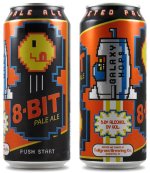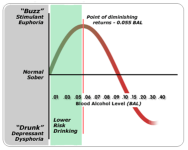I have had this theory for a while and might have posted before about it. Basically alcohol has a J-curve dose-response and is a STIMULANT at low dose. It works in a biphasic fashion, just because a lot is harmful doesn't mean a little bit isn't beneficial. Many drugs, vitamins, anti-oxidants, poisons, and even exercise itself work in this biphasic manner.
There are actually a few studies to back this up.
http://www.ncbi.nlm.nih.gov/pubmed/11900782
So I have taken to drinking beer as a workout drink at the gym. Don't worry I don't drive there, one of my gyms (actually it's a golf/country club) has 4 locations near me and 1 is within walking distance so I run there.
Before/during workouts I drink this stuff called 8-bit pale ale because A. it's delicious and B. it looks like an energy drink and nobody at the gym knows I'm actually drinking beer!

Like I said this works on a J-curve as illustrated below (upside down J) so only 1 or 2 beers will do it. The goal is NOT to be drunk, only slightly buzzed. It really does let you get more reps though. It's also a vasodilator, boosts testosterone and is neuroprotective against ischemic injury at LOW doses, stimulates your adrenal gland and causes your liver to dump sugar in to your blood.

There are actually a few studies to back this up.
http://www.ncbi.nlm.nih.gov/pubmed/11900782
The stimulant effects of alcohol were assessed in humans. Twenty social drinkers were tested in dyads in the laboratory on three separate occasions, held 7 days apart. For their first session, one-third of the group consumed a dose of alcohol that was calculated to reach a target peak blood alcohol concentration (BAC) of 0.05 g/dl, one-third of the group consumed placebo-alcohol, and one-third consumed diet Sprite. For alcohol and placebo-alcohol conditions, subjects were told that they may or may not be given alcohol. For the soda condition, subjects were told they were consuming soda. Subjective stimulation, activity levels, and speech production were assessed over a 15-min period after beverage consumption (posttreatment) and compared to measurements taken prior to beverage consumption (baseline). Scores on the stimulant subscale of the Biphasic Alcohol Effects Scale (BAES) were significantly greater for the alcohol condition relative to the soda condition. There was also a trend for stimulant scores to be greater for the alcohol condition relative to the placebo-alcohol condition. Activity levels were significantly greater for the alcohol condition compared to either the placebo-alcohol or soda conditions.
So I have taken to drinking beer as a workout drink at the gym. Don't worry I don't drive there, one of my gyms (actually it's a golf/country club) has 4 locations near me and 1 is within walking distance so I run there.
Before/during workouts I drink this stuff called 8-bit pale ale because A. it's delicious and B. it looks like an energy drink and nobody at the gym knows I'm actually drinking beer!

Like I said this works on a J-curve as illustrated below (upside down J) so only 1 or 2 beers will do it. The goal is NOT to be drunk, only slightly buzzed. It really does let you get more reps though. It's also a vasodilator, boosts testosterone and is neuroprotective against ischemic injury at LOW doses, stimulates your adrenal gland and causes your liver to dump sugar in to your blood.




